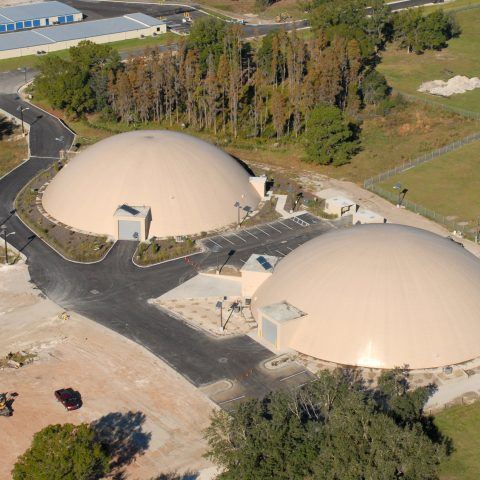The same structures industrial companies rely on for storing the most sensitive bulk products are an ideal option for data centers.
Dome Technology’s steel-reinforced concrete dome is weatherproof, natural-disaster proof, and climate controlled. The free-spanning interior makes every square foot accessible, and the exterior’s nondescript appearance draws little attention.
Robust construction is not new to Dome Technology, which has built structures for the nuclear industry that meet Nuclear Regulatory Commission guidelines and fall in line with the FLEX safety initiative. For these reasons and those detailed below, a dome sets the stage for ideal data security.
Ultimate climate control
Large data centers can demand as much electricity as a small town, and when hundreds of machines are running, interior temps are bound to rise. A dome’s concrete shell acts as a continuous and uninterrupted thermal battery that collects heat as it rises, minimizing the need for air conditioning as the heat is absorbed into the structure itself. Mechanical systems discharge that heat and keep interior temperatures within an acceptable range. Polyurethane foam insulation with an R-value of 50 further ensures energy efficiency and fewer temperature fluctuations inside.
Natural-disaster resistance
With a dome, protection of the computer environment comes standard. Combined with steel reinforcement and nature’s perfectly strong shape, our domes are undeniably robust, making them ideal for weathering any storm.
Domes are frequently built as storm shelters based on their tolerance fornatural disaster. A dome can be engineered to withstand winds exceeding 250 mph (which includes EF5 tornadoes) and can be built to meet ICC-500 specifications.
Domes are also a choice option in areas prone to seismic activity because a seamless concrete shell makes it possible for a dome to resist seismic loads. Monolithic construction means a dome is free from corners or concrete beams meeting up to create a joint, a construction interface that creates a weak point that doesn’t exist in monolithic construction. The absence of weak points in the shell allows the structure to convert loading to an axial force going across the surface of the dome, rather than channeling the stress to a weak spot.
Customization
Domes are customized to each customer’s specifications, including necessary systems for operations inside. In the case of data centers, that means providing systems to power computers, backup power supplies, redundant communications connections, and security devices.
Flexible space planning
Data centers benefit from flexibility in floor space. The dome is truss and column free, granting ultimate freedom in space planning. The dome can also be built tall enough to accommodate multiple floors.
Cost efficiency
Data centers can be expensive to build and require continuous maintenance. The dome mitigates both concerns; the seamless concrete shell with its exterior PVC membrane requires minimal upkeep. Costs are kept low because concrete construction produces very little material waste, and money is funneled back into the economy as local tradespeople are hired to build the structure and provide materials.

